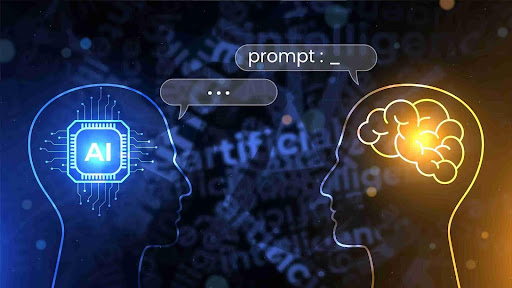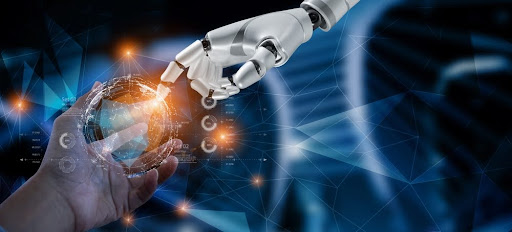
The rise of artificial intelligence (AI) in various sectors has sparked an ongoing debate: Is AI a collaborator or competitor in the digital age? While AI has revolutionized industries from healthcare to finance, concerns remain about whether it will eventually replace human workers or if a harmonious collaboration is possible. In exploring AI vs. Human interactions, it becomes essential to examine both the competitive aspects and the potential for mutually beneficial partnerships, offering a hopeful and optimistic view of the future.
AI is not replacing people in Digital Marketing

Artificial intelligence is rapidly transforming industries, sparking concerns about whether intelligent systems might replace human workers. With the AI market projected to grow by a staggering 154 percent in 2019, its integration into various sectors is undeniable, emphasizing the urgency of understanding and adapting to this technology. However, only some fields are adapting AI similarly.
In digital marketing, for example, AI is not primarily seen as a replacement for human roles. A survey by IAB Europe and Xaxis found that only 6 percent of digital marketing agencies consider replacing humans as AI’s primary application. Instead, the technology is being used to enhance business processes and improve audience targeting. Around 60 percent of marketers reported using AI to deliver better targeting, while 55 percent were leveraging it to identify users and audiences more effectively.
The Competitive Landscape: Where AI Outshines Humans
AI, with its unique capabilities that often surpass human abilities, particularly in areas involving vast amounts of data processing, automation, and predictive analytics, is revolutionizing the manufacturing industry. The Role of AI in enhancing the capabilities of Industrial Robots is a prime example. AI-driven robots are not just tools, but transformative agents, improving precision, speed, and efficiency in manufacturing.
These robots can perform repetitive tasks with minimal errors and adapt to new tasks through machine learning algorithms, all of which significantly boost productivity. By integrating AI, industrial robots become more versatile and capable, showcasing the synergy between AI and automation in enhancing operational efficiency across various industries.

1. Speed and Efficiency: AI systems, with their unparalleled ability to analyze data at speeds that are impossible for humans to match, are reshaping decision-making processes. In fields like finance, AI’s real-time data analysis capabilities outcompete human processing speeds, enabling rapid decision-making that can give businesses a competitive edge.
2. Automation of Repetitive Tasks
: AI, with its ability to take over mundane, repetitive tasks, is a cost-saving boon for businesses. By increasing efficiency and reducing costs, AI is transforming industries like manufacturing and logistics, where optimization of processes and improvement of output are key.
3. Accuracy and Precision: In healthcare, AI-powered systems assist in diagnosing diseases by analyzing medical images with a level of accuracy that significantly reduces the likelihood of human error. This precision demonstrates AI’s reliability in tasks that require exactness.
4. Predictive Capabilities
: AI excels in predictive analytics, from forecasting consumer behavior in marketing to predicting equipment failures in industrial settings. These capabilities enable organizations to manage risks and seize opportunities proactively.
The Collaborative Potential: How Humans and AI Can Work Together
AI, with its unparalleled data-processing capabilities, and humans, with their nuanced understanding, empathy, and ethical reasoning, each bring unique strengths to the table. While AI and automation streamline data management, it’s human insight that is crucial to interpret and apply data in meaningful ways. The collaboration between these two entities has the potential to transform industries in powerful ways, leveraging their respective strengths to create more efficient and effective systems. By combining AI’s data-processing capabilities with human creativity and ethical considerations, we can foster innovation that is both technologically advanced and deeply attuned to human needs.

1. Augmented Decision-Making: AI can analyze complex data and provide insights, but it’s the irreplaceable human judgment that remains essential for interpreting these insights and making strategic decisions. In medicine, for example, AI can suggest treatment options based on data, but it’s the doctors who make the final call, factoring in the patient’s unique needs.
2. Creative Innovation: AI can be a creative collaborator by providing new ideas, trends, or insights that humans might not have considered. However, it’s the human touch that’s crucial in refining and personalizing these AI-generated ideas. In fields like music, AI can suggest chord progressions or generate melodies, which musicians can then refine and personalize, adding their unique creativity to the mix.
3. Enhanced Customer Experiences: In customer service, AI-driven chatbots handle common inquiries, relieving human agents from routine tasks and allowing them to focus on resolving more complex or sensitive issues. This division of labor not only improves efficiency but also ensures that customers receive a personalized and empathetic experience when needed, making the workload more manageable for human agents.
4. Training and Upskilling: As AI automates routine tasks, it creates opportunities for humans to develop new skills and focus on high-value work. Upskilling initiatives in companies help employees transition to roles where they supervise AI or work in tandem with it, fostering a collaborative workforce.
Navigating the Ethical Implications of AI
As AI becomes more integrated into society, ethical considerations must be addressed to ensure responsible development and usage. This is particularly crucial when developing assistive technologies, such as Revolutionizing Navigation: The AI-powered blind stick for visually impaired.

1. Transparency and Accountability: AI systems should be transparent, with understandable decision-making processes. Clear accountability frameworks ensure that when AI makes decisions, humans can trace and verify these processes to maintain trust.
2. Bias and Fairness: AI algorithms can unintentionally perpetuate biases present in training data. It is essential for humans to regularly audit and refine AI systems to ensure they operate fairly and without discrimination.
3. Data Privacy: As AI relies heavily on data, safeguarding individuals’ privacy is paramount. Humans must establish and enforce strict data privacy protocols to protect personal information from misuse.
4. AI Governance: Establishing global AI governance frameworks can ensure that AI development aligns with ethical standards. Humans play a vital role in shaping policies that define the boundaries of AI’s capabilities.
Conclusion
As we advance further into the digital age, the choice between AI and Humans need not be binary. Instead, embracing AI and Human collaboration can lead to a future where both entities thrive. AI’s unique strengths, such as its speed and precision, can enhance human creativity, empathy, and ethical reasoning. By fostering a partnership, industries can unlock new levels of innovation, productivity, and problem-solving capabilities, giving us hope for a brighter future.
The narrative of AI vs. Human is evolving into one of AI and Human collaboration. With mindful integration and responsible governance, this synergy can help us address global challenges and improve the quality of life for all. As we move forward, the focus should be on cultivating a shared future where AI empowers humanity to achieve the extraordinary. I urge you to join this conversation and contribute to the responsible integration of AI in our society.
Moonpreneur is on a mission to disrupt traditional education and future-proof the next generation with holistic learning solutions. Its Innovator Program is building tomorrow’s workforce by training students in AI/ML, Robotics, Coding, IoT, and Apps, enabling entrepreneurship through experiential learning.
























It would be interesting to see more examples of how AI and humans can work together to complement each other, especially in education and healthcare. Looking forward to more insights on this evolving relationship!
While AI excels in processing large amounts of data quickly, it lacks the emotional intelligence, creativity, and ethical judgment that humans possess. These qualities are essential for making nuanced decisions, especially in fields like healthcare, education, and leadership. AI should complement human abilities, not replace them.